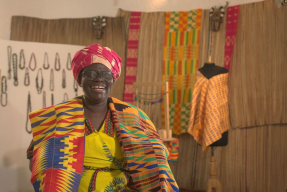In my time as a fellow, I expected to interview borrowers and hear lots of touching personal stories. I never expected to finally understand economics in a way textbooks never described it for me. Economics was not a course I chose to take. It was a mandatory credit I had to take. While I managed to memorize how supply and demand curves moved, for the life of me, I could not see the practical applications of economic theory. This was the case until a very special aha moment last week thanks to my field experiences and a fantastic discussion with CRAN’s Director of Microfinance. I finally understood the interplay of demand and supply at a very practical level. Upon reflection, I am starting to believe that a vital assumption for microfinance to be a success story is that there is continued excess demand in the marketplace. But what happens if supply exceeds demand?
In the two months that I have been at CRAN, I’ve interviewed over 130 borrowers and have started noticing themes in the type of businesses that these borrowers have. There are vegetable sellers, food sellers, second-hand clothing sellers, and provision (convenience store) stall owners. It seems that a lot of the borrowers are selling a product of sorts. And when asked about how they used their loan, the most common response is that they increased their stock. By increasing their stock, the borrowers were able to increase their sales and profits. Thus, their businesses grew. While this sounds like a success story, I find myself asking, how long can this growth be sustained? How many vegetable sellers does one small village need? And if one of the premises of microfinance is to graduate clients to higher loan amounts, how long can you keep graduating vegetable sellers in a village before the supply of vegetables exceeds what the village can consume?
This becomes a demand and supply issue. I’ll walk you through a simple example. Let’s say that in a hypothetical village, the demand for tomatoes is $2,000. There are 5 tomato sellers in the market and none have taken out micro-loans before. Here’s the scenario:
- Prior to taking any loans: Each of these 5 tomato sellers has $200 worth of stock. So in total, $1,000 worth of tomatoes are sold. There are opportunities to grow in this market, because not all the demand for tomatoes is being met.
- 1st cycle of loans: The MFI sees an opportunity in this village and gives loans to each of the 5 tomato sellers. They can now increase their stock to $300. So the total supply of tomatoes is $1,500 and there are still opportunities for growth.
- 2nd cycle of loans: All the clients grow their sales, repay their loans, and improve their businesses. The MFI decides to graduate these 5 tomato sellers to higher loan amounts where now, they each have $400 worth of stock. The total supply of tomatoes is now $2,000. Supply matches demand and the market is at equilibrium.
- 3rd cycle of loans: After another cycle of successful repayments, the MFI decides to graduate these clients yet again. Now, each of the 5 tomato sellers has $500 worth of stock. The total supply of tomatoes is now $2,500, which exceeds demand.
In this case, what do you do at cycle 3? When there’s excess supply in the market and these clients have to repay their loans regardless of their ability to sell, you’re bound to see some clients become delinquent or default altogether. In a situation where demand is held constant, at one point, you will hit a ceiling where you can’t graduate clients any longer. When facing this situation, you have to either stop graduating clients, or graduate some clients at the expense of losing other clients, or go to a different geography to continue expanding your services.
This also brings up the question of the purpose of microfinance. If microfinance is access to capital for populations not served by the commercial banking system, then not graduating clients is not necessarily an issue. In this case, you are still providing clients with a service that they need. However, it is a different story if you view microfinance as a development tool where clients are more empowered after each loan cycle and eventually reach a position where they can access loans from the commercial banks. If this second definition is how an MFI defines its mission, then situations where supply outpaces demand can really challenge the pursuit of this mission.
I’m starting to believe that a key assumption in microfinance as a development tool is that there’s excess and growing demand for goods in a given marketplace. This excess demand facilitates graduating clients to higher loan amounts and maybe eventually to accessing loans from commercial banks. Macroeconomic factors that increase job creation, purchasing power or demand for goods and services become critical to an MFI’s success. Without a productive labour force that has the purchasing power, a micro-entrepreneur will inevitably face a demand cap for the goods and services that he or she provides.
At an operational level, MFIs have to be very observant on the demand and supply factors faced by its clients in the different markets that it operates. It is important that loan officers are trained on observing, inquiring about, and analyzing these factors. The health of an MFI’s portfolio very much depends on it. CRAN’s Director of Microfinance told me that this hypothetical example is actually not too different than the day-to-day realities that MFIs face. I can’t help but marvel at the economic forces at play. What a pleasure it is to better understand a topic that was inaccessible to me before.
By Zerrin Cetin, KF12 Ghana
PREVIOUS ARTICLE
Kiva Passport Series: Microfinance in Afghanistan →NEXT ARTICLE
Celebrate Kiva's 5th Birthday and get $25 to lend! →















